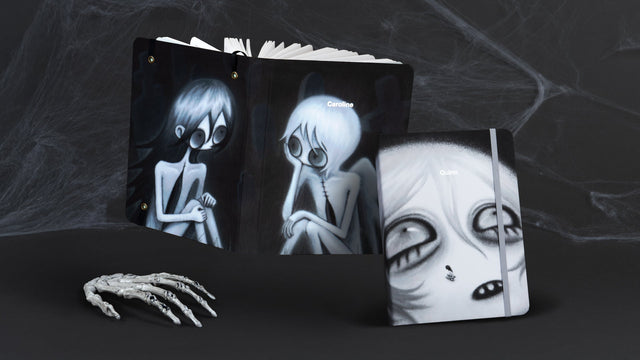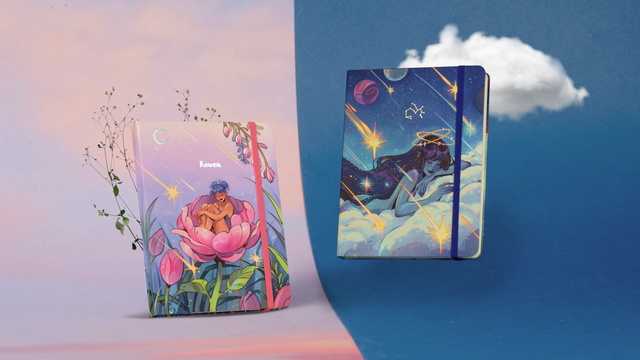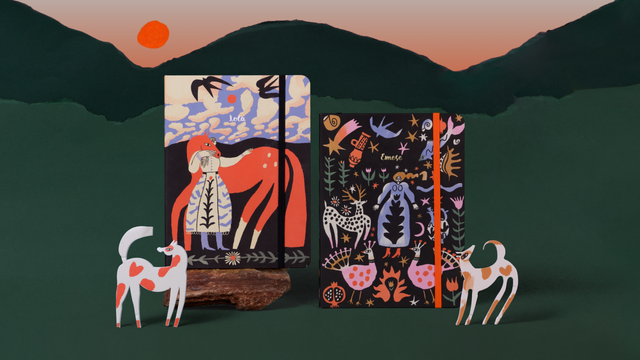One of our dreams when starting a blog was to talk to creatives around the world, diving into the minds behind the beautiful artwork we see coming to life on our sketchbooks. We hope you’ll enjoy this series as much as we did working on it.

Here for the first instalment of our interview series is Angelyn Peh, a self-taught illustrator from Kuala Lumpur, Malaysia.
When we first stumbled upon her Instagram account back in 2016, we were surprised to see someone using our planner and pocket notebooks as our customer base had been much smaller at the time.
We were enchanted by the intricacy of her artwork and the thought that went into each piece, so we reached out to her with one of our sketchbooks… and the rest is history.
Read more about her creative process and inspirations (both childhood and current) below.

Tell us, what / who do you draw inspiration from the most?
Books and music. Anything well-written. Other artists' work and the way they see the world. Rainy days. Bus rides in the afternoon. Dim lighting and long talks. Along with too many musicians, directors, artists, and authors to list, honestly.
Two that come to mind specifically: Lorde – emotionally mature, a master of self-expression, elegant, and a little strange. If rhythms and beats had a form, look no further than Lorde during her performances, a marionette jerked and jostled into movement purely by sound.
Ana Victoriana Calderón – an artist and illustrator with some of the most vibrant, magical, incredible watercolour works I've ever seen. I love her Skillshare classes. Her curiosity to learn more about and push the boundaries of her craft is infectious.

What mediums do you prefer to use and why?
Pencils and pens, because I love my lines, especially when it comes to portraiture. I used to be pretty into coloured pencils as well, the texture that you can get is beautiful.
Watercolours – even though I'm technically still new to this very iffy and time-consuming medium, I've found that brushstrokes have a wonderful, therapeutic feeling. Watching the paints mix in the water as well is mindfulness at its best, really.
How would you describe the Mossery Sketchbook to others?
Having come from a drawing background, sketchbooks I can paint in are still a novelty for me – so that's what I'd start with! The mixed media paper is versatile and can be used with a wide variety of mediums, so you can try new things and also revert to techniques you're already familiar with.

Finally, I'd end by talking about the lovely cover options and one of my favourite features: the name/quote personalisation. I normally choose a couple of words from favourite quotes of mine, so as to give the sketchbook a theme.
Tell us about your favorite place to find inspiration. Also, do you have a muse of sorts?
Instagram and Pinterest go without saying of course, as does travel. Movies, TV shows – anything with stories. Music – translating the auditory into a visual is always a welcome challenge. Other than that, my most reliable source of inspiration is books: as long as I'm reading, chances that I'll illustrate something are high. I am an artist because I am a reader.
Muses... I love the idea of that. I could name a lot of artists whose works I like, but when it comes to muses, there are a significant three who come to mind:
Pauline Baynes. She, along with Beatrix Potter, was one of my first introductions to art, and she set the foundation for literally everything art related for me. Her blend of movement and elegance is perfection, as is her attention to both detail and negative spacing. (There's a high chance I'll continue singing her praises in later questions, so moving on for now.)

Vincent van Gogh. His life, his art, his writing... There's nothing I can say about him that hasn't already been said. He knew how to see beauty in things so ordinary that others wouldn't even realise they were looking at them. He was an incredible man with an incredible soul, and I can only aspire to have half the amount of heart he had.
Lisbeth Zwerger. While having a different style from Pauline Baynes', she evokes a similar feeling in her art: whimsicality, soft but playful colour palettes, a sort of wistfulness. Her work should pass off as children's illustration at first glance, but there's so much depth to each piece that it hits like a punch in the heart instead. She's a master of imagery, and her lines are so fine they could be whispers. Her textures remind me of old book pages, or moth-eaten tissue paper.

Do you believe in talent?
I do believe that some people have a natural bent when it comes to art, but I also believe that anyone who puts their mind to it will pick up the skill sooner or later.
Talent is a great indicator of what you naturally gravitate to, but relying on it and buying into the idealism that naturally accompanies it can end up being a stumbling block: hard work (and a good dose of hard knocks) is what gets you to where you want to be.
You have a very strong sense of storytelling element in most, if not all of your works. And you have the tendency to couple words with illustrations. Why is that?
I feel like something's missing when I separate the two. With the words, I see colours and forms that aren't represented visually. With art, it would be a little... well, sacrilegious to leave out the syntax and flow of the words that inspired the visuals.

I know that a picture tells a thousand words, and to some extent that's true, but that sentiment lessens words in a way – words are their own very distinct form of beauty. They take a little more patience to appreciate, but once you really get into the act of reading, there's no limit to the things they prompt your mind to see.
At the risk of stating the obvious, it's entirely possible to paint with language; use the right words and syntax and you'll be amazed at the varying textures, tones, and even rhythms you can make just in a sentence.
Basically, my aim is to pay homage to both visuals and words as individual forms of art.
On that note, you also seem to be strongly inspired by Narnia. Tell us a little bit about that, and perhaps, some other books that have served as your main sources of inspirations in illustration.
It's difficult to articulate what drew me to Narnia in the first place, because I was a pretty dreamy kid who had strong intangible impressions of lots of things.
That in itself – my childish appreciation – is a big part of why I treasure those books; they represent a significant period in my life where I was discovering beauty, sadness, and ephemerality for the first time, and in a very pure way.

And of course, there were the stories themselves. Pauline Baynes' illustrations shaped both the way I saw the world and the way I created my own art, but they were all the more significant because of the words they were based on. (And considering that Baynes and C.S. Lewis didn't have the best working relationship, it's amazing that the artwork and the stories married the way they did. But I digress.)
Lewis knew how to make magic with few words: he wrote characters that leapt off the pages, created worlds while you watched in awe and tore them apart while your heart broke. To have discovered stories like this as a child is a privilege I don't take lightly.

Other books... There was a huge tome of illustrated Russian ballet tales and folklore borrowed from the library. And also a collection of illustrated abridged Shakespeare plays as a birthday gift when I was eight. And then I naturally flowed from Narnia to the Hobbit and The Lord Of The Rings when I was nine or ten.
If Lewis watched over my childhood, Tolkien took over for my adolescence and teenage years and is still going strong now. It may sound dramatic, but I honestly cannot imagine what sort of person I'd be now if I had never read Tolkien's works.
These books were all illustrated, but their stories are what shaped me and instilled the need to translate my subconscious, abstract reactions into something visual – beauty, sadness, and ephemerality you could see.
What advice would you give to your younger self?
Don't take yourself so seriously. Have fun and make mistakes, what matters is that you came up with an imperfect result instead of holding on to an unachievable vision.

Don't try so hard to get it right or do the right thing all the time – best intentions aside, you will get things wrong. And that's fine. If you don't make mistakes, you'll never learn.
Last but not least, get out of your own way. I still need to repeat this to myself from time to time, to be honest.
If you’re given only one word to describe yourself, what word would it be and why?
Sincere. I'm driven nearly a hundred percent by sincerity. Whatever I do, it has to come from a place that's honest or at least emotionally resonant.
There've been a fair number of mixed results over the years (because I was sincerely wrong a lot), but it's a streak of my character I haven't been able to shake. Whether that's fortunate or not is something I have yet to find out.

Finally, tell us a secret.
I've always wanted to play in the string section of an orchestra for movie scores. (Preferably cello, although the double bass would be an interesting challenge.) Still do, actually.
–
Find Angelyn and her beautiful works on Instagram at @angelynpeh.




Posted 03 August 2020 at 09:04 by Eileen
Angelyn is one of my favorite artists, I’ve always felt her strong connection with stories, her gift at storytellingand her way with words, I really admire the way she can convey it with her art, now I feel like I know her a little bit more